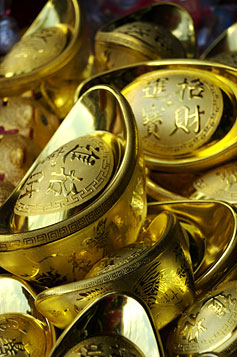

One World
Nations Online
All Countries in the World
 |
 One World Nations Online All Countries in the World |
| Home |
||
___ Yuanbao, Sycee, Ingot, Good Luck Coins Yuanbao (Sycee), Ingot, Good Luck Coins are symbols of prosperity and wealth. |
||
| YUANBAO The most common shape of a yuanbao is boat shaped, elliptic, oval, with a circular or oval little 'bump' in the middle. A yuanbao is a small metal ingot that was used in ancient China as money. Being made out of silver or gold, the value was determined by weight in taels, which is a weight measurement, part of the Chinese system of weights and currency (see also: baht). Yuanbaos were made by individual silversmiths for local exchange. Hence, the shape and amount of each yuanbao/ ingot were highly variable. The amount of each yuanbao/ ingot was detailed on its bottom, while the most common shapes were oval or square, but "boat", flower, tortoise and others shapes were known as well. Today- except for the fact that the Chinese currency is still called ‘yuan’ and ‘yuan’ translates to ‘round’- as in the shape of a coin- imitation yuanbaos are a symbol of prosperity, income and /or wealth, frequently seen as design or decoration on items in connection with Chinese New Year. INGOT COINS |
 Sycee/Yuanbao ingots Photo © Valeska Gehrmann |
|
|
|
||
Country information: China | Bhutan | Hong Kong | India | Japan | Korea | Laos | Malaysia | Mongolia | Nepal | Singapore | Taiwan | Tibet | Thailand | Vietnam More Countries in Asia Map of Southeast Asia Back to the index of Chinese Customs and Traditions Glossary |
Bookmark/share this page
|
|
One World - Nations Online .:. let's care for this planet To the mind that is still, the whole universe surrenders. 老子 |
| Site Map | Information Sources | Advertise with OWNO | Disclaimer: Privacy Policy, etc. | Contact: [email protected] | Copyright © 1998-2016 :: nationsonline.org |